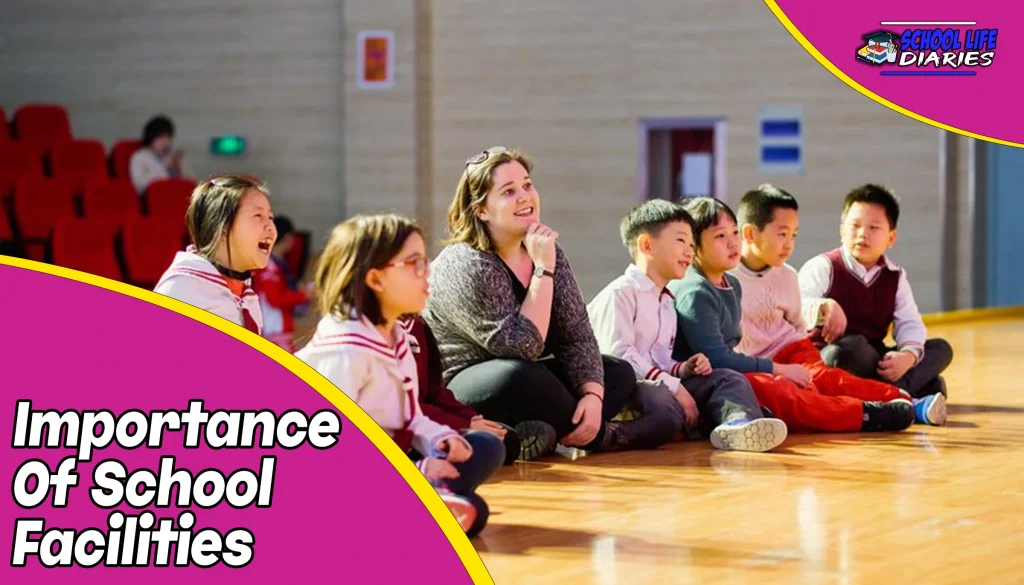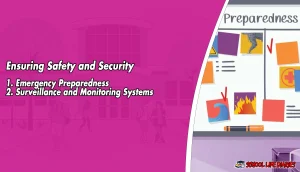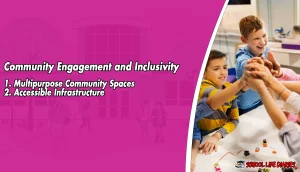School facilities play a crucial role in creating an optimal learning environment for students. The importance of school facilities lies in their ability to enhance the learning experience, provide diverse learning opportunities, foster creativity and talent, ensure safety and security, and promote community engagement and inclusivity.
With well-designed and equipped facilities, schools can create a conducive atmosphere that enables students to thrive academically, emotionally, and socially. Enhancing the learning environment is one of the primary functions of school facilities. Adequate classrooms with comfortable seating arrangements, proper lighting, ventilation systems, and acoustics contribute to a positive learning atmosphere.
Enhancing the Learning Environment
This discussion will explore the importance of school facilities in enhancing the learning environment. It will focus on three key points:
- Aesthetic appeal and learning: Aesthetic appeal plays a crucial role in creating an engaging and stimulating environment for students, influencing their motivation to learn.
- Comfort and well-being: Comfortable and well-designed spaces can contribute to students’ overall well-being, positively impacting their focus and concentration during lessons.
- Technology integration: The effective integration of technology in classrooms enables innovative teaching methods and enhances student engagement with the curriculum.
Aesthetic Appeal and Learning
The aesthetic appeal of school facilities has been shown to have a positive impact on students’ cognitive functioning and learning outcomes. The physical environment in which students learn plays a vital role in their overall educational experience. When school facilities are aesthetically pleasing, it creates a sense of pride and belonging among students, leading to increased student engagement and academic success.
Research suggests that an attractive learning environment can enhance student engagement. When students are surrounded by visually appealing spaces, they are more likely to feel motivated and interested in their academic pursuits. Aesthetically pleasing classrooms, libraries, and common areas create a welcoming atmosphere that encourages active participation and collaboration among students.
The aesthetic appeal of school facilities is not merely superficial but has significant implications for student engagement and academic success. Creating visually appealing spaces within educational institutions enhances student motivation, collaboration, creativity, attention span, and information-processing abilities while fostering a positive attitude toward learning.
Comfort and Well-being
Comfort and well-being are crucial factors to consider in the design of educational spaces, as they significantly impact students’ overall experience and academic outcomes. One key aspect of ensuring comfort and well-being in school facilities is providing comfortable seating options for students. Sitting for long periods can be physically demanding, leading to discomfort and even pain.
The pressures of academic demands can take a toll on student’s mental health, making it crucial to provide areas where they can unwind and recharge. Relaxation areas equipped with comfortable seating, soft lighting, and calming elements such as plants or soothing artwork can offer a refuge from the stressors of the school day. These spaces allow students to take breaks when needed, promoting emotional well-being and reducing anxiety levels.
Technology Integration
Technology integration in educational spaces has the potential to revolutionize teaching and learning, transforming traditional classrooms into dynamic, interactive environments that inspire curiosity and foster a deep connection with the subject matter. By incorporating technology tools such as computers, tablets, interactive whiteboards, and online resources, students can engage with the material in new and exciting ways. These tools enable teachers to present information in a visually appealing manner, making abstract concepts more accessible and easier to understand.
Integrating technology into educational spaces offers numerous advantages for both teachers and students. It goes beyond simply replacing traditional methods; it opens up new possibilities for engaging with subject matter while fostering collaboration and critical thinking skills. By embracing technology integration, schools can create an environment that sparks curiosity and empowers students to take an active role in their own education.
Enabling Diverse Learning Opportunities
This discussion will explore the key points of libraries and resource centers, laboratories, and practical learning, as well as sports and recreational facilities in enabling diverse learning opportunities.
Libraries and Resource Centers
Libraries and resource centers play a crucial role in providing students with access to a wide range of learning materials and resources. These facilities are not just spaces filled with books, but rather dynamic hubs that foster the development of information literacy skills and enable collaborative learning.
Learning resources available in libraries go beyond textbooks, encompassing digital databases, online journals, multimedia materials, and more. This diverse collection allows students to explore various topics and perspectives, expanding their knowledge beyond what is covered in the classroom..
Overall, libraries serve as essential components within educational institutions by providing access to a multitude of learning resources while fostering information literacy skills and collaborative learning opportunities.
Laboratories and Practical Learning
Libraries and resource centers are essential components of a well-equipped educational institution, providing students with access to a vast range of knowledge and resources.
Laboratories play a crucial role in enhancing students’ understanding of theoretical concepts by allowing them to apply these principles through practical experimentation.
This multidisciplinary approach enables them to see the interconnectedness of different branches of science and fosters a holistic understanding of the world around them. While libraries equip students with abundant resources for research and study, laboratories offer a unique space for practical experimentation and hands-on learning.
Sports and Recreational Facilities
Sports and recreational facilities contribute significantly to the overall development of students, fostering physical fitness, teamwork, and discipline. These facilities provide students with a platform to engage in various sports activities that help in enhancing their physical well-being.
Proper maintenance of the equipment ensures that students can participate in these activities without any hindrance or safety concerns. Moreover, sports scholarships offered by schools based on student’s performance on the field motivate them to excel not only academically but also athletically. Through team-building exercises and competitions held within these facilities, students develop a sense of camaraderie and unity which are vital for their personal growth.
Overall, sports and recreational facilities play a crucial role in shaping the holistic development of students. The maintenance of equipment ensures a safe environment for them to engage in physical activities effectively.
Fostering Creativity and Talent
This discussion will focus on the importance of arts and cultural spaces, as well as auditoriums and performance stages in fostering creativity and talent within a learning environment. Arts and cultural spaces provide students with opportunities to explore their artistic abilities, express themselves creatively, and develop a deeper understanding of different cultures.
Arts and Cultural Spaces
Art and cultural spaces within schools provide students with the opportunity to explore and express their creativity in a supportive and enriching environment. These spaces are essential for arts education, as they offer a dedicated area where students can engage in various artistic activities such as painting, sculpting, dancing, or acting.
These spaces provide an avenue for self-expression that goes beyond traditional academic subjects. By engaging in artistic activities within a supportive environment, students are encouraged to think outside the box, explore their own unique talents, and develop a sense of appreciation for different cultures.
Auditoriums and Performance Stages
Auditoriums and performance stages serve as platforms for students to showcase their artistic abilities and talents, providing them with a public space to express themselves creatively. These spaces play a pivotal role in promoting the arts within the school community, allowing students to engage in various forms of performing arts such as music, dance, theater, and more. Performance showcases held in auditoriums not only offer an opportunity for students to gain confidence but also allow them to share their talents with their peers, teachers, and even parents.
Auditoriums and performance stages provide valuable opportunities for students to express themselves artistically while serving as a platform for showcasing their talents. The inclusion of professional stage lighting techniques and high-quality sound systems further enhances the overall experience for both performers and audience members alike.
Ensuring Safety and Security
Ensuring safety and security in schools involves various key points such as emergency preparedness, surveillance, and monitoring systems. Emergency preparedness is crucial to effectively respond to any unforeseen events or crises that may occur within the school premises. The implementation of surveillance and monitoring systems helps to monitor activities and ensure the overall security of students, staff, and school property.
Emergency Preparedness
To effectively address emergency situations, it is crucial for schools to have robust plans and resources in place. Emergency response, disaster preparedness, and crisis management are key components of ensuring the safety and security of students and staff within educational institutions.
Schools should establish comprehensive emergency response plans that outline specific procedures to be followed during various types of emergencies, such as natural disasters, fires, or acts of violence. Having a well-thought-out disaster preparedness plan allows schools to respond swiftly and efficiently in times of crisis. This includes conducting regular drills and simulations to familiarize students and staff with emergency protocols. Regular maintenance checks on these resources should also be conducted to ensure their functionality when needed.
By prioritizing emergency preparedness measures within school facilities, educational institutions can create a secure environment for learning while instilling a sense of confidence in their stakeholders. Students will feel safer knowing that their school has taken the necessary precautions to protect them from potential harm.
Surveillance and Monitoring Systems
Surveillance and monitoring systems play a crucial role in enhancing the security and protection of educational institutions by providing constant vigilance and deterring potential threats. These systems consist of various surveillance cameras strategically placed throughout the school premises, as well as advanced monitoring technologies that enable real-time tracking and analysis of suspicious activities. By utilizing these security measures, schools can create a safe environment that fosters learning and growth for students.
Surveillance systems in schools act as a deterrent to potential threats by creating a sense of constant vigilance. Knowing that they are being monitored, individuals with malicious intentions may think twice before attempting any harmful behavior within the school premises. Moreover, these systems allow for quick identification and response to any suspicious activities or emergencies.
Community Engagement and Inclusivity
This paragraph discusses the importance of community engagement and inclusivity in school facilities. One key point is the provision of multipurpose community spaces, which can serve as gathering places for various activities and events that involve both students and members of the wider community.
Multipurpose Community Spaces
Multipurpose community spaces in schools play a crucial role in fostering social interaction and promoting engagement among students, teachers, and community members. These spaces serve as hubs where individuals from different backgrounds can come together, exchange ideas, and build relationships. By providing accessible infrastructure that caters to the diverse needs of the community, these multipurpose spaces promote inclusivity and create an environment that encourages collaboration.
Multipurpose community spaces in schools serve as catalysts for social interaction and engagement among students, teachers, and community members. They promote inclusivity through their accessible infrastructure that enables equal participation for individuals from diverse backgrounds.
Accessible Infrastructure
Transitioning from the previous subtopic of multipurpose community spaces, we now turn our attention to another crucial aspect of school facilities: accessible infrastructure. Accessible facilities play a vital role in creating an inclusive and barrier-free environment for all students, regardless of their physical abilities. In recent years, there has been a growing recognition of the importance of designing schools with inclusive features that accommodate diverse needs and promote equal opportunities for learning.
One key aspect of accessible infrastructure is the incorporation of inclusive design principles. Inclusive design goes beyond meeting minimum accessibility standards; it aims to create environments that are usable by everyone, irrespective of their age, size, or ability. By adopting inclusive design principles in school facilities, educational institutions
Conclusion: Importance Of School Facilities
In conclusion, the importance of school facilities in the realm of education cannot be overstated. School facilities play a multi-faceted role in shaping the learning experience, safety, and inclusivity within educational institutions. The optimal design and equipping of these facilities create an environment conducive to academic growth, creativity, physical well-being, and community engagement.
Enhancing the learning environment through aesthetics, comfort, and technology integration positively impacts students’ engagement and cognitive function. Aesthetic appeal not only beautifies spaces but also stimulates motivation and interest in learning. Comfortable and well-designed areas contribute to students’ overall well-being, aiding in concentration and focus during lessons. Technology integration empowers educators to adopt innovative teaching methods, making learning more engaging and accessible.
Ensuring safety and security is paramount in educational institutions. Comprehensive emergency preparedness plans and surveillance systems create a secure environment, instilling confidence in students and staff. Community engagement and inclusivity are achieved through multipurpose community spaces and accessible infrastructure. These spaces serve as gathering points, encouraging interaction and collaboration among diverse individuals.










